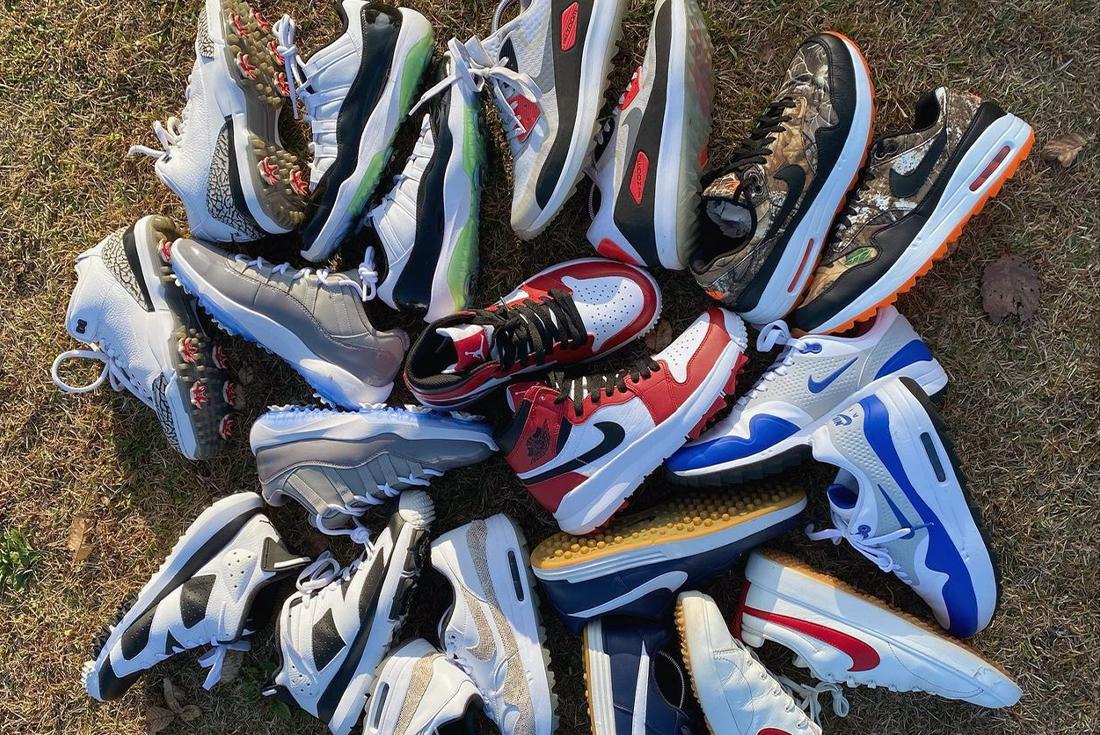Hype for Hackers: How Sneaker Culture Infiltrated the Golf World
Despite its global – and growing – popularity, hasn't always been the most progressive sport, and even its most zealous disciples would struggle to argue otherwise. Long steeped in tradition, golf is now a multi-billion-dollar industry – and an spectacle – that is finally moving away from its pretentious past into a new era of enlightenment.
Unfortunately, golf's adoption of the athletic/aesthetic movement has been as slow as a Sunday morning tee time – somewhat ironic considering many have been wanting it to be accepted as a 'real sport' for decades. Thankfully, however, the ball is now rolling – and rolling fast.
As part of that modern evolution of the game, sneakers are now at the top of the leaderboard when it comes to hot commodities for the course, but how did we get here? And why the hell has it taken so long?

The appearance of the shoes remained relatively the same for decades (did we mention golfers were change-averse?), but the outsoles were a constant work in progress, with spike design evolving all the way until the early 90s. The steel spikes were gratingly loud when walking on anything but turf, and also damaged everything they treaded on, including the putting greens, which required constant maintenance. It took almost a century for the steel spike leave the market, with plastic becoming the go-to spike material by the time the year 2000 rolled along. Greenskeepers across the globe breathed a collective sigh of relief.
The adoption of the plastic spike opened the floodgates for experimentation when it came to golf shoe design, as did the rise of an up-and-comer by the name of Eldrick ‘Tiger’ Woods. Backed by , the fresh-faced American prodigy was ready to change the game and its antiquated footwear, forever.
Nike Golf has since used Tiger's footwear line as a vehicle for progression, packing in their latest innovations and smashing any notions of what a traditional golf cleat is meant to be. Not in the least surprising considering he's arguably the hardest trainer the game has ever seen.
After sporting a prototype with Free technology in 2011, Tiger debuted the Nike TW 13 the following year. Looking for a shoe that gave him the same performance fit and feel as the Free shoes he used for running and training, Tiger's design ethos was simple. 'I train with Nike Free technology all the time,' said Woods. 'I love training in it, running in it, lifting in it. So I asked, why can't I play golf in it?'
Today's golfer is asking themselves a similar question when it comes to sneaker-style golf cleats.
If you love the look and feel of an Air Jordan 1, why can't you adapt it for the course? Well, thanks largely to Tiger's influence on the game, Nike did just that… and it's just one of the countless fashion-to-fairway crossovers to release in the last 15 years.

Naturally, brands like Nike, , and were quick to expand their golf footwear lineups following in Freddy's spikeless footsteps. It made total sense, as they already had the market share when it came to golf's casual crowd. The next few years saw spikeless golf shoe sales skyrocket, with many pros also switching to the easier-wearing style.
We had to wait a few years, but the first legitimate high-profile sneaker moment in the golf realm can be traced back to as recently as 2017, when Aussie golfer Jason Day rocked a not-so-subtle white pair of Air Jordan 1 Golfs at the Open Championship (the world’s oldest major no less). Back then, you didn’t see high-tops on the golf course very often, but when you did, old hackers lost their minds… Day got proper roasted by purist factions of the golf fraternity, and has since never worn the 1s on course, which is a bit of a shame if you ask us.
Thankfully, Jordan Brand ignored the outrage, proceeding to expand their own in-house golf shoe lineup, while also releasing golf adaptations of all-time classics such as the Air Jordan 3, Air Jordan 4, Air Jordan 5, and Air Jordan 11 Low. Nike did the same, applying the 'G' treatment to the Air Max 1, Air Max 90, Air Max 97, and Air Max 270, all of which were just as versatile off the course thanks to their spikeless soles.
More recently, adidas have caught on, introducing the and ZX 8000 to the course, while PUMA have finessed an RS-Golf in the same vein.

As more people take up the game amid the pandemic – is there a better sport for social distancing? – we're also seeing more collaborations between these progressive golf labels like and , who have recently released limited edition projects alongside (not a traditional player in the golf market) and Jordan Brand, respectively.
While it's difficult to quantify, the growing popularity of the game probably owes a lot to the sneakersphere. Whether you're shooting over 100 or breaking par, it's good to know a pair of AJ1s won't break on-course dress codes anymore.
